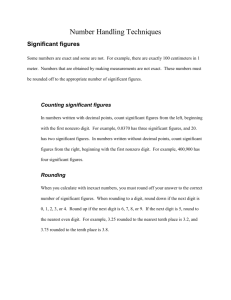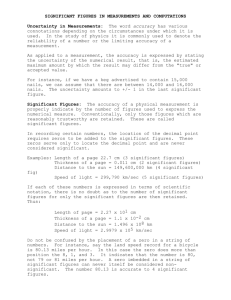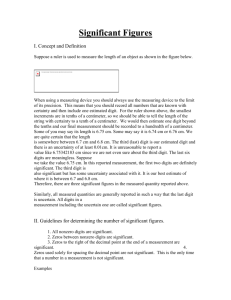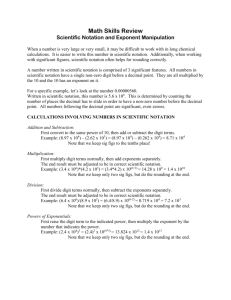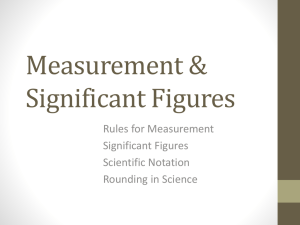Scientific notation and rounding worksheet
advertisement
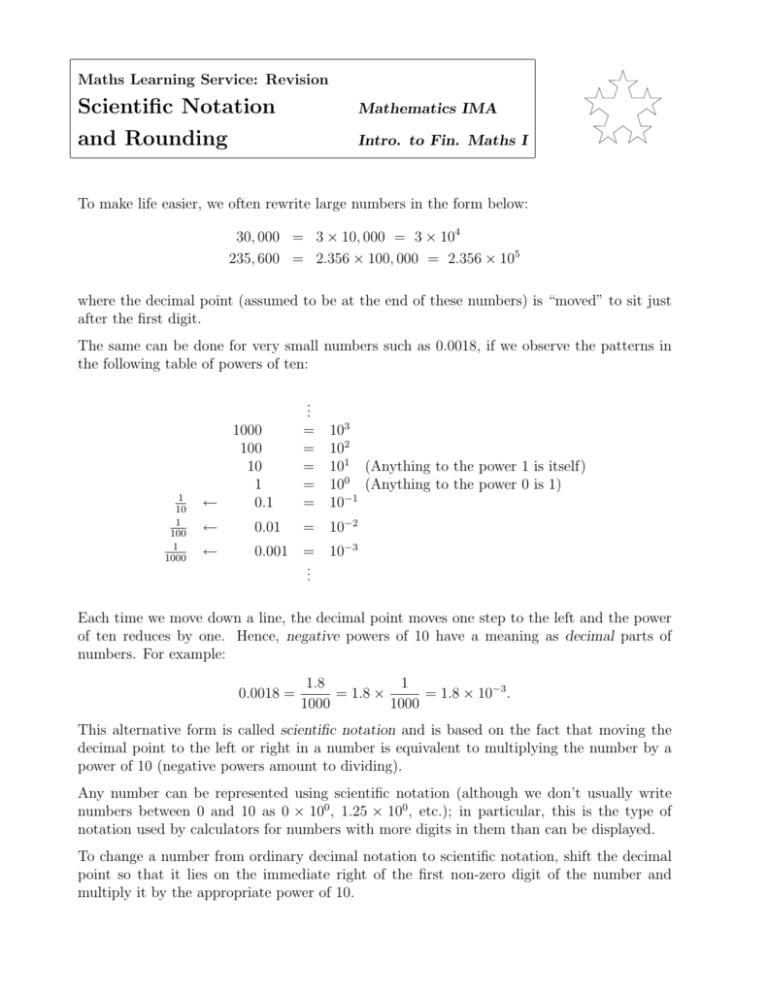
Maths Learning Service: Revision Scientific Notation and Rounding Mathematics IMA Intro. to Fin. Maths I To make life easier, we often rewrite large numbers in the form below: 30, 000 = 3 × 10, 000 = 3 × 104 235, 600 = 2.356 × 100, 000 = 2.356 × 105 where the decimal point (assumed to be at the end of these numbers) is “moved” to sit just after the first digit. The same can be done for very small numbers such as 0.0018, if we observe the patterns in the following table of powers of ten: 1 10 1 100 1 1000 ← 1000 100 10 1 0.1 .. . = = = = = 103 102 101 (Anything to the power 1 is itself) 100 (Anything to the power 0 is 1) 10−1 ← 0.01 = 10−2 ← 0.001 = 10−3 .. . Each time we move down a line, the decimal point moves one step to the left and the power of ten reduces by one. Hence, negative powers of 10 have a meaning as decimal parts of numbers. For example: 0.0018 = 1.8 1 = 1.8 × = 1.8 × 10−3 . 1000 1000 This alternative form is called scientific notation and is based on the fact that moving the decimal point to the left or right in a number is equivalent to multiplying the number by a power of 10 (negative powers amount to dividing). Any number can be represented using scientific notation (although we don’t usually write numbers between 0 and 10 as 0 × 100 , 1.25 × 100 , etc.); in particular, this is the type of notation used by calculators for numbers with more digits in them than can be displayed. To change a number from ordinary decimal notation to scientific notation, shift the decimal point so that it lies on the immediate right of the first non-zero digit of the number and multiply it by the appropriate power of 10. Scientific Notation and Rounding 2007 Maths IMA & Intro. Fin. Maths I Revision/2 Here are some examples: (a) (c) (e) 69, 000, 000 = 6.9 × 107 1 = 0.25 = 2.5 × 10−1 4 1200 = 133.3̄ = 1.3̄ × 102 9 (b) 0.0000000837 = 8.37 × 10−8 (d) 1 = 0.0027̄ = 2.7̄ × 10−3 360 (f) 3.1762 × 10−2 = 3.1762 × 1 = 0.031762 100 Exercise (1) Convert to Scientific notation or vice versa: 2.9 × 104 (a) 3, 800, 000 = (b) = (c) 0.000019 = (d) = 1.57 × 10−4 (e) 7 8 = (f) 7000 3 = Rounding Numbers and Significant Figures In mathematics, the exact solution to a calculation may involve many (if not infinitely many) decimal places. For example, if we wanted to make a rectangular frame where one side was 1 metre in length and the other had to be two thirds of this, the exact length required would be 0.6666 . . . metres. For practical purposes we would probably only need to measure “to the nearest millimetre” (0.667 metres). The number 0.667 is said to have three significant figures and we have rounded off at the third decimal place. Significant figures are all digits present in a number with the exception of ‘place marking’ or leading zeros in purely decimal numbers. Here are some other examples: Number Significant Digits 32.023 0.00019 1.00019 1.000 5 2 6 4 The leading zeros in the second example vanish if you write 0.00019 as 1.9 × 10−4 . Notice that ‘trailing zeros’ are important as these indicate the level of accuracy of the measurement as much as any other digits. Scientific Notation and Rounding 2007 Maths IMA & Intro. Fin. Maths I Revision/3 The rounding process is as follows: (i) Decide where you want your rounded value to stop. (ii) Look at the next digit on the right; if it is a 5, 6, 7, 8 or 9 then increase the last digit of the rounded value by 1. 0, 1, 2, 3 or 4 then do nothing. Examples: (1) Round 7.389056 to two decimal places. Solution: The second decimal place is 8. The next digit on its right is 9 which is more than 5. Therefore we increase 8 by 1 and so the rounded value is 7.39. (2) Round 32143 to four significant digits. Solution: The fourth digit along is 4. The next digit on its right is 3 which is less than 5. Therefore, 32143 is closer to 32140 than to 32150. It is ambiguous to leave the zero in so we can convert to scientific notation giving 3.214 × 104 as the required value. (3) Round 4639.75 to the nearest whole number. Solution: In this case we have to round the number off at the last digit before the decimal point. The next digit on its right is 7 which is more than 5 so we increase 9 by 1. Since we can’t replace 9 by 10 directly, in this instance we replace 9 by 0 and increase the next digit on its left by 1. Therefore, the rounded value is 4640 (and can be left that way, or as 4.640 × 103 ). Note: In general, if we have a number ending in a string of 9’s, then we repeat the last step above as many times as necessary. (4) Round 0.05̄ = 0.0555 . . . metres to four significant figures. Solution: The fourth non-zero digit is 5. The next digit on its right is also 5. Therefore, we increase 5 by 1 and so the rounded value is 0.05556 metres. Exercises (2) (3) Convert the following to scientific notation and state the number of significant figures: (a) 0.003280 (b) 7, 990, 010.6 (d) 0.000 000 985 1 (e) 814, 184, 149.00 (c) 18.004 Write your answers to the previous question correct to two significant figures. Scientific Notation and Rounding 2007 Maths IMA & Intro. Fin. Maths I Revision/4 Answers to Exercises (1) (a) 3.8 × 106 (b) 29, 000 (c) 1.9 × 10−5 (e) 0.875 = 8.75 × 10−1 (f) 2.3 × 103 (2) (a) 3.280 × 10−3 , 4 (b) 7.9900106 × 106 , 8 (e) 8.1418414900 × 108 , 11 (3) (a) 3.3 × 10−3 (e) 8.2 × 108 (b) 8.0 × 106 (d) 0.000157 (c) 1.8004 × 101 , 5 (c) 1.8 × 101 (d) 9.9 × 10−7 (d) 9.851 × 10−7 , 4

